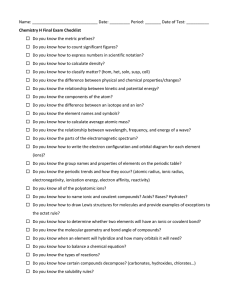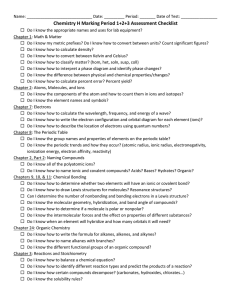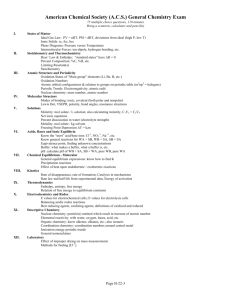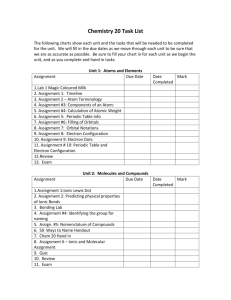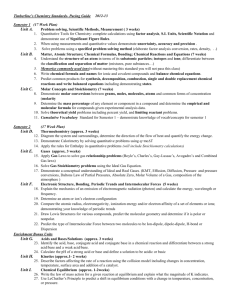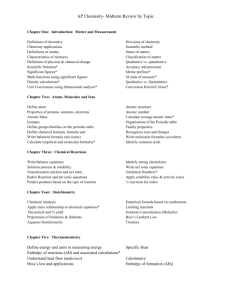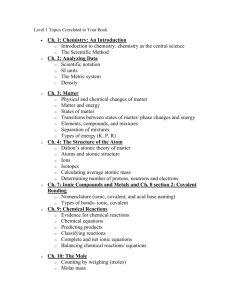AP Final Review - Tri
advertisement
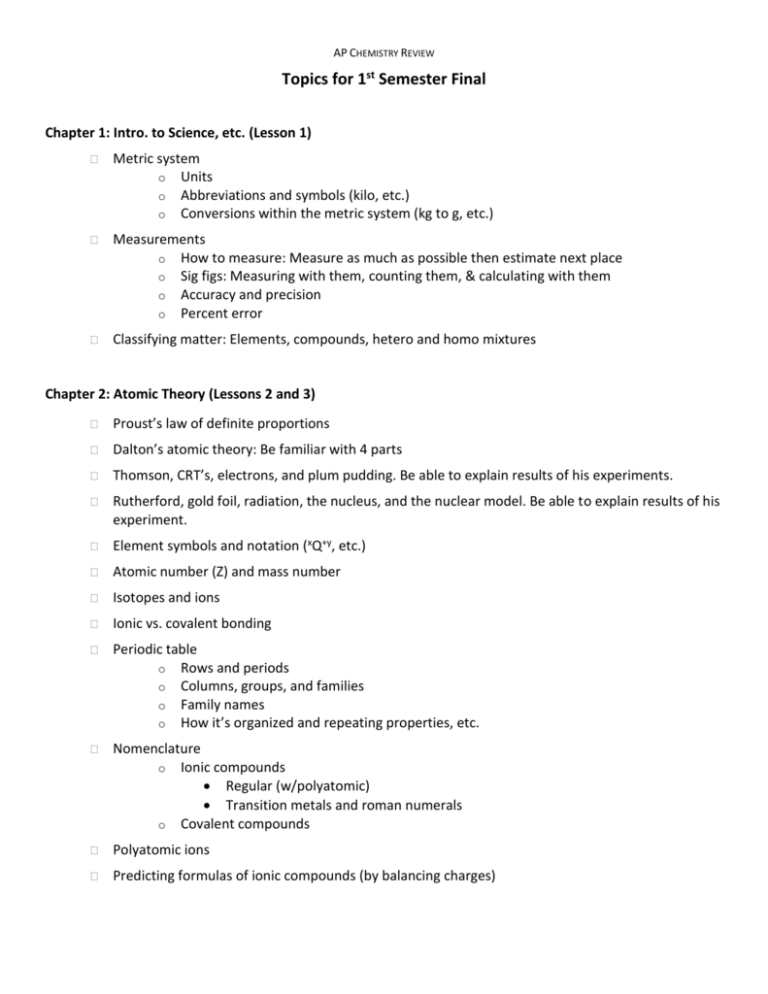
AP CHEMISTRY REVIEW Topics for 1st Semester Final Chapter 1: Intro. to Science, etc. (Lesson 1) Metric system o Units o Abbreviations and symbols (kilo, etc.) o Conversions within the metric system (kg to g, etc.) Measurements o How to measure: Measure as much as possible then estimate next place o Sig figs: Measuring with them, counting them, & calculating with them o Accuracy and precision o Percent error Classifying matter: Elements, compounds, hetero and homo mixtures Chapter 2: Atomic Theory (Lessons 2 and 3) Proust’s law of definite proportions Dalton’s atomic theory: Be familiar with 4 parts Thomson, CRT’s, electrons, and plum pudding. Be able to explain results of his experiments. Rutherford, gold foil, radiation, the nucleus, and the nuclear model. Be able to explain results of his experiment. Element symbols and notation (xQ+y, etc.) Atomic number (Z) and mass number Isotopes and ions Ionic vs. covalent bonding Periodic table o Rows and periods o Columns, groups, and families o Family names o How it’s organized and repeating properties, etc. Nomenclature o Ionic compounds Regular (w/polyatomic) Transition metals and roman numerals o Covalent compounds Polyatomic ions Predicting formulas of ionic compounds (by balancing charges) AP Chem 1st Semester Review Topics 2 Chapter 3: Stoichiometry (Lessons 4 – 6) Atomic mass Definition: a weighted average How to calculate The mole (like, duh!) Calculating numbers of molecules/atoms in a sample (the bicycle thing) Molar mass Percent composition Empirical formulas Definition and examples Determining from percent composition Determining molecular formula given EF and MM Hydrates: determining hydration of a compound Writing and balancing equations Stoichiometry, limiting reactants, and percent yield Types of reactions: synthesis, decomposition, single replacement, double replacement, and combustion Lab: Determination of empirical formula, stoichiometry Chapter 4: Solutions (Lessons 7 – 11) How things dissolve: the role of water molecules Strong, weak, and nonelectrolytes: Definitions, how to determine, and examples Drawing solutions: how electrolytes break apart Solvent, solute, and solution: definitions Molarity How to make solutions Glassware and its use Beer’s Law: A = lєc Precipitation reactions Predicting precipitates using memorized solubility rules Molecular, complete ionic, and net ionic equations Solution Stoichiometry Acid-base reactions Definitions of acids and bases Titrations, endpoints, and calculating equivalence points Fall 09 AP Chem 1st Semester Review Topics 3 More Chapter 4: Solutions Redox Definition of reduction and oxidation Assigning oxidation numbers Identifying elements reduced and oxidized Identifying oxidizing and reducing agents Balancing redox reactions Writing half-reactions Acidic vs. basic solutions Know common oxidizing and reducing agents and their products Possible lab questions: Qualitative analysis, Beer’s Law and spectrophotometry/colorimetry, titrations (acid-base or redox), Determining molar mass of acid, etc. Chapter 5: Gases (Lessons 12 – 13) Pressure Units and conversions Instruments to measure pressure and how they work Gas laws Boyle, Charles, Avogadro, Combined, and Ideal Absolute zero and Kelvin scale Plugging and chugging Graphs Gas stoichiometry STP (0oC and 1 atm) Mole fractions, χ Partial pressures Kinetic Molecular Theory 4 assumptions; know which are incorrect Explaining gas laws using KMT Relation of Temp, average KE, and velocity Effusion and diffusion Definitions Calculations Real gases What’s wrong with KMT When a gas behaves most ideally (High T and low P) and why How van der Waal’s equation compensates Acid rain and the atmosphere Possible lab question: Plotting Boyle’s or Charles’ law, Determining molar volume of a gas Fall 09 AP Chem 1st Semester Review Topics 4 Chapter 6: Thermochemistry (Lessons 14 – 15) We can divide the universe into 2 parts: System – What we’re looking at Surroundings – Everything else Processes are either endothermic or exothermic: Endothermic – Requires input of heat from surroundings for reaction to go; system feels cool to the touch; ΔH < 0 Exothermic – Releases heat into the surroundings as process occurs; system feels hot to the touch; ΔH > 0. At constant pressure, Enthalpy (H) = Heat (q) Enthalpy is a state function: Only initial and final conditions matter, not how you got there. 5 ways to determine enthalpy change (ΔH) of a reaction: 1. Coffee Cup Calorimetry: Using q = H = mcT 2. Bomb calorimetry: Using q = H = cT 3. Stoich: the more stuff you use in your reaction, the more heat involved 4. Hess’s Law: Adding reactions and their enthalpy changes 5. Standard Enthalpies of Formation, H of , and standard states: Using tabulated data Chapter 12: Kinetics (Lessons 16 – 17) Reaction Rates: Relative rates, initial rates, instantaneous rates, average rates, and how to read them from a concentration vs. time graph Rate laws: regular (differentiated) and integrated: 0th, 1st, and 2nd order Determining the rate of a reaction: o Method 1: Initial rates and the regular rate law o Method 2: Graphing and the integrated rate law Half-lives Activation energy (Ea) and transition state Identifying points on a reaction diagram (both forward and reverse reactions): energies of reactants, products, and transition state; activation energy; ∆H Catalysis: How it works and how it affects a reaction diagram Mechanisms: How a reaction happens, writing a rate law for each elementary step, determine overall rate law given slowest step OR determine slowest step given overall rate law Fall 09 AP Chem 1st Semester Review Topics 5 Exam Format Our final will mimic the format and style of the AP test and use actual test questions, but will of course be only half as long. Part 1 will be 30 multiple choice questions. Time = 40 minutes. Only a periodic table is provided; no equations are given and calculators are not allowed. There will be a ¼-point deduction for each incorrect answer. Part 2 is free response. Time = 55 minutes. There will be two calculation-based questions, two essay-based questions, and a predicting products question. One of the questions will cover a lab we’ve done. Pay attention to sig figs. A periodic table and a sheet of equations and constants will be provided; calculators are allowed. The test will be scaled like the AP exam to give you a “feel” for your projected AP score should you continue on your current trajectory. Start studying early! Typical Averages: 50% before the curve (77% after the curve) Fall 09
